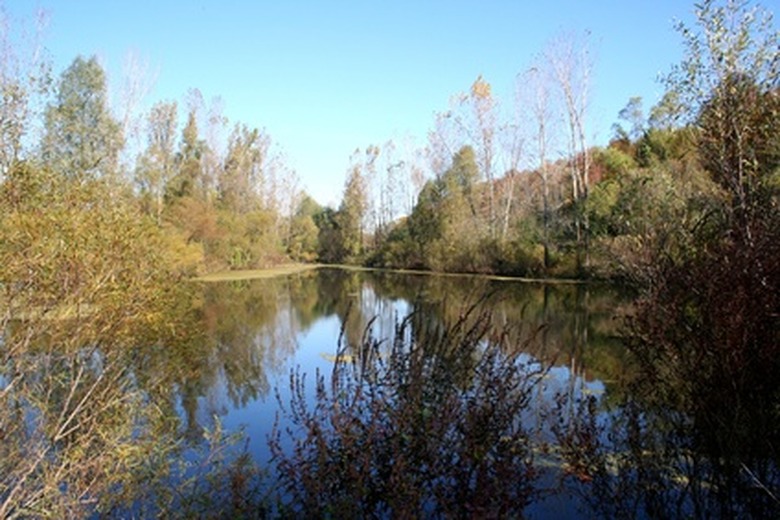How To Make A Self-Sustaining Ecosystem
An ecosystem is defined as a given area where biotic, living organisms, interact with each other and their abiotic, non-living, environment. Biotic members of an ecosystem include plants, animals, fungi, bacteria and viruses. Abiotic components of an ecosystem include water, soil, air, light and temperature.
Read more about the 8 ecosystems.
What Is a Self-Sustaining Ecosystem?
What Is a Self-Sustaining Ecosystem?
A self-sustaining ecosystem is a mini ecosystem in a jar or other clear container. Think of it like having a diverse little fish tank that you don't need to add anything to or feed because it does everything itself. All it needs is light. Self-sustaining ecosystem terrariums can be terrestrial, aquatic or a combination of both environments, which is called a paludarium.
What Factors Are Needed to Have a Self-Sustaining Ecosystem?
What Factors Are Needed to Have a Self-Sustaining Ecosystem?
Just like any ecosystem, a self-sustaining ecosystem needs light for primary production and nutrient cycling. The environment must find an ecological balance and be able to support the survival and reproduction of all organisms living inside it. Too many animals can result in all the plants getting eaten and oxygen used up too quickly. Too many plants may result in overcrowding and death.
Read more about the abiotic and biotic factors of an ecosystem.
Types of Self-Sustaining Ecosystems
Types of Self-Sustaining Ecosystems
Ecosystems can be open or closed systems. Closed systems, such as ecosphere shrimp, are entirely sealed from the outside world. Open systems are more like a traditional fish tank system with an open lid. Aquatic terrariums can either be fresh or saltwater, although due to the chemical complexities of saltwater, freshwater systems are considered easier to set up and run.
Kinds of Plants Suitable for Terrariums
Kinds of Plants Suitable for Terrariums
In terrestrial terrariums, moss is a common base plant for sealed systems. Ideally select slow-growing plants such as:
- ferns
- carnivorous plants
- air plants
- succulents
- dwarf palms
- peperonia
The type of plants you use will depend on the type of soil. For example, soil requirements for cactus and succulents will differ to that of moss.
What Types of Animals Can Be Used in a Self-Sustaining Ecosystem?
What Types of Animals Can Be Used in a Self-Sustaining Ecosystem?
The type of animal will depend on the size of the enclosure. Shrimp prefer to be kept in pairs or social groups and require at least 1 gallon of water per shrimp. Small enclosures may only be able to sustain tiny plankton. In aquatic ecosystems, the use of pond weed from a natural source will promote the growth and protection of bacteria, algae, copepods, isopods, snails or polychaete worms if conditions are right.
Vertebrates, such as fish, need more room and produce more waste products than invertebrates such as snails, shrimp or copepods and may not be suitable for these types of enclosures. A bioactive terrarium ecosystem can be created for reptiles, frogs or terrestrial invertebrates with live plants to give them a naturalistic enclosure with minimal interference. Bioactive terrariums are not entirely self-sustaining and need some care and maintenance.
How to Make a Self-Sustaining Terrarium
How to Make a Self-Sustaining Terrarium
First, select a glass or plastic container that is a suitable size for the plants and animals it will keep. For terrestrial terrariums, place a layer of stones and then activated carbon to help keep the system clean, plus a layer of peat moss to help retain moisture before adding soil. Now plant the plants. In aquatic terrariums, start with a layer of gravel and then top with a layer of sand before adding water and planting plants.
All kinds of terrestrial and aquatic terrariums require light. Ensure they are kept in an area with plenty of natural sunlight or have access to a light source that emits the entire light spectrum. Once properly functioning, terrariums require little care; however, for the first few days, they will need to be checked regularly to make sure they have the right light, moisture and nutrient levels.
References
- University of Michigan: The Ecosystem and How It Relates to Sustainability
- Green Growing: How to Make a Self-Sustaining Ecosystem: 5 Steps and Ideas
- Reeko's Mad Scientist Lab: How to Create a Terrarium (or Vivarium or Self-Contained Bottle Garden)
- Fishkeeping World: The Definitive Guide to Creating a Paludarium (Tank, Plants and Building Suggestions)
- Reptile Apartment: Bio-Active Terrarium Plants – A Walkthrough
- Science Learning Hub: Ecosystems: What Is an Ecosystem?
- Northern Arizona University: Bottle Biospheres
- University of California Press: The American Biology Teacher: Pond in a Jar
- It's Not Just a Fish Foundation: Beginner's Guide to Aquarium Plants
- Science and Children: Ecosystem in a Jar
- Aquariu Info: Setting up Your Shrimp Aquarium
Cite This Article
MLA
Jerrett, Adrianne. "How To Make A Self-Sustaining Ecosystem" sciencing.com, https://www.sciencing.com/make-selfsustaining-ecosystem-6098416/. 22 November 2019.
APA
Jerrett, Adrianne. (2019, November 22). How To Make A Self-Sustaining Ecosystem. sciencing.com. Retrieved from https://www.sciencing.com/make-selfsustaining-ecosystem-6098416/
Chicago
Jerrett, Adrianne. How To Make A Self-Sustaining Ecosystem last modified August 30, 2022. https://www.sciencing.com/make-selfsustaining-ecosystem-6098416/
